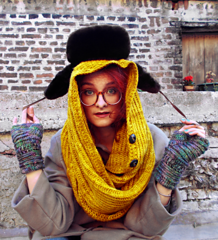patterns >  Teri B.'s Ravelry Store
Teri B.'s Ravelry Store
> Amdam








Amdam
Flash Sale: Get 25% off all my patterns! Promotion ends on March 4, 2019 at 23:59 GMT. No coupon code needed; the discount will be applied at checkout :)
How Amdam came to be:
Amdam means comforter in Khuzdul, the language of the Dwarves in Tolkien’s universe.
In the Hobbit, the dwarves making Thorin’s company live on the road, with no real home of their own. They have to make do with what they can carry, and this is where the idea for Amdam stemmed from.
If you have to live on the road, you want things that are multipurpose – convertible. Now, these dwarves do go the extra mile and carry a harp and viols big as themselves around (in the book, that is) but still… there has to be a limit to what they can carry (unless, you know, they get their hands on a bag of holding, but that’s another story/franchise).
In the case of a stole/scarf/cape, you’d want it to be thick enough to help keep you warm/dry, but not too chunky in case you’d have to fold it and stuff it into your bag. Not too heavy, either – you’d have to lug the darn thing about, after all.
And, without a home, you have to find comfort where you can – I’ve always found handknitted items comforting, and I like to think the Dwarves of Erebor would’ve found comfort in such things, too.
The shape of Amdam is inspired by dwarven architecture, as it appears in Alan Lee and John Howe’s illustrations and concept art and in Peter Jackson’s movies. It uses lots of repetitive patterns and lots of straight lines. It’s very geometric - some would say quite block-y. And yet, there’s always a certain hint of luxury, an elegant feel to it. An air of grandeur. Dwarves are a proud people. Their halls are built to impress – at least that’s how I see it. But Dwarves are not fussy. They’re pragmatic (or, well, they like to think they are…) – and their architecture shows it. There are no squiggly lines anywhere to be seen. Squiggly lines and floral motifs are for pointy eared devils, after all.
I had all these things in mind when I chose brioche as the main stitch pattern for Amdam: brioche is straightforward, but more luxurious and refined than regular ribbing. It’s very geometric and looks good when repeated across a sizable project. It’s squishy and comfortable. It drapes well and can be folded rather easily.
The crocheted spine and border add a little flair to the stole without being too frilly, and they’re also useful. The spine helps keeps the stole in shape and the border, while also keeping the stole in shape, doubles as a button band.
For more information, pictures, tips on how to wear Amdam and stitches tutorials, feel free to check: http://theknittingraven.blogspot.com/2016/12/amdam.html
………………………………………………………………………………………………
Supplies:
-5 skeins (1050 yards) of Malabrigo Merino Worsted (210 yards per 100g) or equivalent yarn.
-5 mm knitting needles (or size to match gauge). A circular needle will be a lot more comfortable to work with, given the weight of the stole, but you can use straight needles if you prefer.
-5 mm (H) crochet hook (or size to match gauges – see Gauge below).
-4 removable stitch markers (can be pieces of scrap yarn or safety pins).
-(Optional) an extra removable stitch marker to help you differentiate the RS from the WS of your work.
-a darning needle to weave in ends.
-7 buttons (1 inch to 1 1/4 inch (25 to 31 mm) in diameter).
………………………………………………………………………………………………
Gauge:
Crocheted spine: 16 FPdc per 10 cm - lightly blocked (recommended crochet hook size: 4 or 5mm)
Knitted body: 12sts/32 rows per 10 cm/4” in brioche - lightly blocked (recommended needle size: 5 or 6mm)
Crocheted border: 10 dc per 10 cm - heavily blocked (recommended crochet hook size: 5 or 6mm)
Crocheted button tab: will use the same crochet hook as for the border.
Lightly blocked: Block the fabric so that it keeps its squishiness. You don’t want to stretch the stitches to their ‘maximum’. The fabric should still have quite a lot of stretch.
Heavily blocked: (only for the border) Stretch the stitches to their ‘maximum’ and make them lay flat. There should be little to no stretch left to them. This means the border will keep its shape and the button holes will fit nicely around the buttons.
Both crochet gauges (lightly blocked spine & heavily blocked border) can be achieved using the same crochet hook (the stole shown in the picture was made using the same 5mm crochet hook). However it would be wiser to still check the gauge before you start - don’t be afraid to use two different crochet hooks if you must. It will be indicated in the pattern when to change your crochet hook in case you have to use two different sizes for the spine and border.
………………………………………………………………………………………………
Difficulty level:
Knitting: Easy to Intermediate (the knitting part will be fairly easy if you already are familiar with brioche knitting)
Crochet: Intermediate (because of the front post dc and back post dc)
Techniques used:
Knitting: k, k2tog, ssk, sl1pwyf, sl1yo, brk, brk2tog, brssk
Crochet: slst, ch, sc, hdc, dc, Fpdc, Bpdc, dc3tog, sc2tog (This pattern uses American crochet terms. )
The instructions are written using the abbreviations above. The most unusual abbreviations are explained in detail in the pattern.
Diagrams are included to show the construction of the stole, blocking dimensions and the construction of the border.
160045 projects
stashed
88176 times
- First published: December 2016
- Page created: December 31, 2016
- Last updated: March 3, 2019 …
- visits in the last 24 hours
- visitors right now




